
Ferry offers exciting trip to Dry Tortugas
DRY TORTUGAS, Fla. — In one of the most inhospitable places, amidst the ghosts and coral reef, you will find the Dry Tortugas National Park. This park showcases the most peculiar mix of beauty and tragedy, the will of nature and the stubborn ambition of man, and death and rebirth.
If you had a slight interest in American history and you also felt like getting wet and checking out some amazingly colorful and exotic underwater flora and fauna, then the Dry Tortugas National Park is the place for you.
It is the home of a Civil War fort that was converted into a prison, Fort Jefferson, and the home to some truly spectacular coral reef life that is growing along the walls of the fort. In fact it may be the only place of its kind in the whole world.
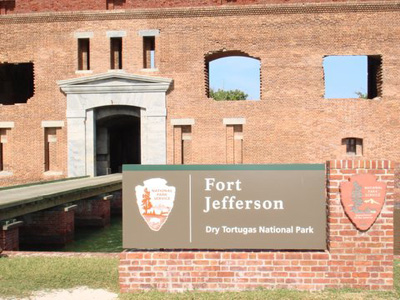 |
The entrance to Fort Jefferson in the Dry Tortugas National Park (Photos by Erick Cipau). |
From its natural seclusion and natural splendor, to its history and current importance in immigration policy, the Dry Tortugas surely are a very special place.
At 7:15 in the morning a crowd of people begins to form out around the Sunny Days kiosk by the marina. People are dragging in as the sun is getting higher in the sky.
The crew members told the crowd to gather and gave some general instructions about the boat and safety. Everything from when food would be served to where you should go if you have the urge to vomit.
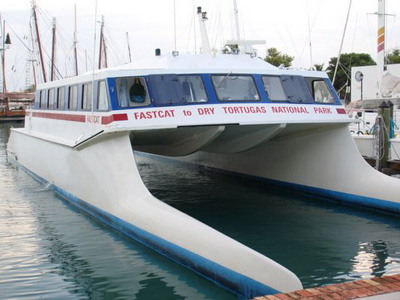 Our engines started at 7:52 and we were moving out of the marina some eight minutes later passing by the Historic Seaport signs and tall-masted sail boats.
Our engines started at 7:52 and we were moving out of the marina some eight minutes later passing by the Historic Seaport signs and tall-masted sail boats.
Once we are past the no wake zone the captain kicks it into high gear and we are off. The boat travels at about 27 knots, or 30 mph, on average.
We are traveling on a catamaran which is a boat that is well balanced over two hulls like legs, as opposed to the conventional boats with a single hull as its body. This design is very beneficial to those who get motion sickness because the balance over two hulls creates more stability and less rocking. But it is impossible to get rid of it all together.
There is an inside and outside to the boat and most people are gathered in the outer section at the back of the boat. The sky is gorgeous, as the sun is beaming through the masses of wisped and puffed clouds. We are speeding over increasingly turquoise waters.
There are about 30 people on the boat and they are all looking forward to what is waiting for them at the end of the journey.
“Our concierge said the snorkeling was just as good if not better than the Bahamas,” said Donna Burns.
Burns is a kindergarten teacher from Fort Lauderdale who is visiting the Dry Tortugas for the first time with her husband, daughter, and her daughter’s fiancé.
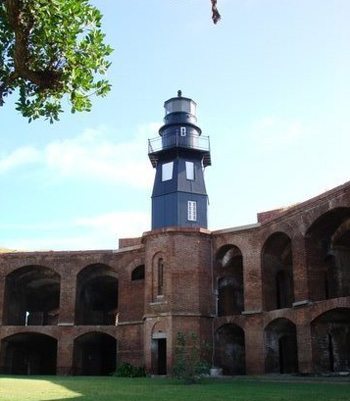 “It will be neat to tell my kids what I saw and did,” said Burns.
“It will be neat to tell my kids what I saw and did,” said Burns.
Some are also coming to get a better grasp on their American history.
“I am a social studies teacher and I have never even heard of Fort Jefferson,” said Heather Reil from Mercer County in New Jersey.
Joining her on her journey is her friend Amanda Thomas, who hails from Asheville, North Carolina where she works as a social worker.
“We were suggesting trips and we have never been down here before so, here we are,” said Thomas.
“The only downside is the two hours that we spend on this boat, but all in all I think it’s worth it,” said Thomas
We finally do come upon the fort and it is amazing to see. After such a long time where there was nothing on the horizon, this fort emerges as a goliath structure. Fort Jefferson is defiantly the most dominant thing on this island that is only 25 acres. We finally pull into the small port of the ships, with no overboard instances to speak of, at around 10:17. Everyone is more than ready to disembark.
Fort Jefferson is steeped in history. It was finished in 1860 and served as a union fort during the civil war. Not one shot was ever fired out of the fort at an attacking force. The fort was later converted to a prison.
Its most famous prisoner, Dr. Samuel Mudd, spent a period of four years in the prison.
Mudd, made infamous by setting the broken leg of President Lincoln’s killer John Wilkes Booth in April of 1865, was sent to Fort Jefferson after being found guilty for assisting in an assassination.
It is still debatable as to whether or not he knew who he was dealing with when he fixed his broken leg.
It is very odd to see this massive fort that looks like it took a good deal of effort so far away from everything else. In between the perfect blues of the sky and water one could image how this would be an ideal location that any soldier would love to be stationed at. We find out later on our tour that just the opposite was the case.
Ponce De Leon found the islands in 1513 on his quest for the fountain of youth. He named them Las Tortugas because of the sea turtles that inhabited the area and also because he felt that the islands resembled turtles.
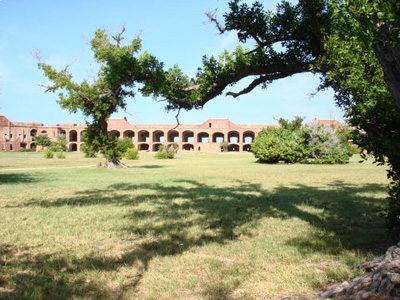 The islands are called dry because no fresh water is available anywhere around the area. This manifested itself as an incredible hardship that the soldiers and prisoners who inhabited the fort had to deal with.
The islands are called dry because no fresh water is available anywhere around the area. This manifested itself as an incredible hardship that the soldiers and prisoners who inhabited the fort had to deal with.
They tried to collect water from rain but unfortunately the Dry Tortugas have great weather almost year round.
On average, only 30 inches of rain falls on these islands in a year. The water that the soldiers were able to catch was piped and collected into cisterns but even that wasn’t a guarantee of water.
As the fort shifted and settled over the years, 106 out of 109 cisterns cracked and were contaminated by salt water.
The soldiers had to resort to boiling salt water just to have the water that they needed to survive.
“The water had to cool down to a warm stagnant, bug filled cup of water,” said Anna Scott.
She is the naturalist for Sunny Days Catamarans. She has spent nine months with Sunny Days and seven months as a tour guide and she is our guide today for our journey through the fort.
Anna pointed out for us in one room, that there were trenches and bowls dug in the flooring by prisoners to collect condensed water so that they would have something to drink.
“They would fight over these with their lives,” said Anna.
It is amazing to think how our government actually thought this would work. We find out that this fort was built under the notion that if we did not take up this territory that someone else would.
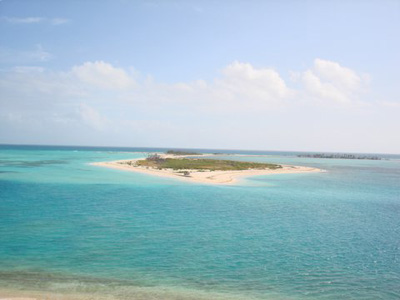 This place became a living hell for those that lived in it. Diseases ran rampant due to the close quartering of everyone in the fort.
This place became a living hell for those that lived in it. Diseases ran rampant due to the close quartering of everyone in the fort.
That added to a contaminated water supply, extreme heat and improper waste management.
The isolation was also a problem. It took us a little over two hours to get to the park but back in 1860 it took weeks for shipments to arrive. It must have taken years to bring in the 16 million bricks that were used to build the fort. Slave labor was also used to build the majority of the fort even though it was a union fort during the civil war and one of the only ones that never left Union control.
When the shipments did arrive they contended with the risk of running aground because the water is so shallow around the islands. Many times ships would come within sight of the fort, only to run aground. Then the soldiers and prisoners would have to wait more weeks to get their vital supplies.
Today it still holds importance because of its proximity to Cuba. When we got to the top of the fort, Anna pointed out something that looked slightly out of place. We were looking at what we were told were boats.
These boats, if they can really be called that, are named “chugs” because of the slow trudging pace that they set in the water. These amateur-made watercraft transport cram Cubans into them to take them from Cuba to the United States. Anna told us that one boat about 10 feet by five feet fit some 25 Cubans into it for a four day journey.
They head out to the Dry Tortugas because, under the Wet Foot, Dry Foot policy on immigration, if they make it and set foot on land on U.S. soil they become a U.S. resident, get $9,000, a meal, and transport to mainland Florida.
If they are caught on water however, they are sent back to Cuba. The Dry Tortugas are a National Park so they count as U.S. soil and they are less monitored by the Coast Guard, making them an ideal entry way into America.
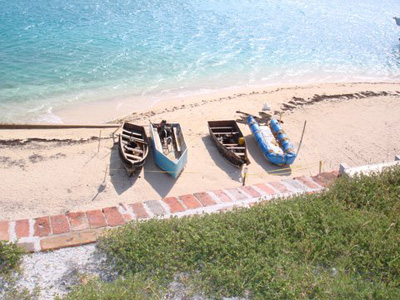 It is ironic to think how something naturally beautiful can be turned into such a God forsaken place.
It is ironic to think how something naturally beautiful can be turned into such a God forsaken place.
“Amidst the refugee boats and bowls of water that the prisoners dug to survive, that got me depressed,” said Heather Reil.
Today we have the technology and capability to make everything more comfortable for ourselves and this gives us and opportunity to enjoy history and nature at the same time.
Now you can zip in and enjoy it all with knowledgeable people who love to help out.
“It’s special to me because some of my family were stationed here and died here,” said Anna
Anna’s sister also enjoys her job and what she does out here.
“If I can’t be on [my boat] I want to be on someone else’s and getting paid; and I like working with the public,” said Katie Scott, who is the older sister of Anna. Katie has worked a little over a month with Sunny Days Catamarans.
Today with the technology and know how that we have, it makes enjoying these isolated areas a lot more practical.
“The Keys, Key West, the Dry Tortugas, all of this place is paradise,” said Katie.
After the tour the group split off, most went snorkeling. What they got to see was more than they bargained for. Under the water it was a myriad of color only slightly muted by the haze of the water.
Coral life was growing all over the walls and brick and slabs. It is incredible to see how nature can grow and thrive with what is given to it.
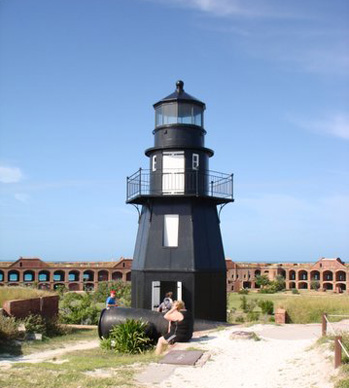 Sea anemones with their fibrous, puffy looking fat fingers swayed gently in the ebb and flow of the current.
Sea anemones with their fibrous, puffy looking fat fingers swayed gently in the ebb and flow of the current.
There were what looked like pieces of paper in different shades of blue and purple with small, intricate snowflake looking designs carved into them also flapping gently with the current. Locked onto the slabs of stone there were circular sections of mini coral domes with small grooves circumventing into a design on top.
The fish were also spectacular. There seemed to be everything from angel fish, to big parrot fish and mangrove groupers, to small fish that were practically glowing with brilliant neon coloring of blue, green and yellow. Sea urchins occupied every hole or gap in the coral along the wall that was big enough to contain them. This served as an understood, “DO NOT TOUCH” sign. We were told earlier not to touch anything, but this solidified the reminder.
Everything was carefree except for the few Portuguese Man of Wars that drifted in and put all of us on alert and spoiled the fun a little. These things looked like plastic bags accented by purple in sections. You could not see them unless you took off your mask and searched the surface of the water or unless you came right up underneath one of them and you were fortunate enough to be looking up. Fortunately no one was stung.
All in all it was a very enjoyable experience for most.
“I loved it! You put that down,” said Heather Reil.
“It was awesome,” said Amanda Thomas in agreement.
Reil enjoyed the type of experience that she had at this park and noticed how it was different than most others.
“You weren’t really confined and had freedom but you never felt like you were out of the element, like you weren’t where you should be,” said Reil.
This is truly a one of a kind park.
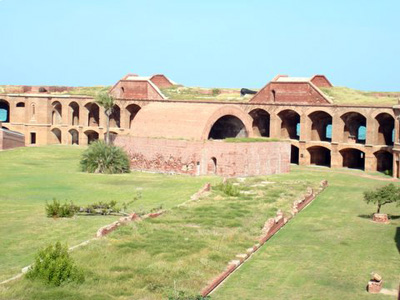
“I think that this is one of the least visited National Parks in America,” said Anna “Others will get millions a year and we only get about 3,500.”
With pristine conditions this is a very special place.
“The waters are more beautiful here than anywhere else in the Keys,” said Anna
The Dry Tortugas has a variety of options available for a variety of different people.
“Some people come here for the birds, some come for the history and the fort, some come for the pristine snorkeling, and others are dragged by their spouses and have no idea why they are there,” said Christian Fagan, the naturalist for the Yankee Freedom boat.
Fagan dispensed some advice on how best to enjoy your experience at the park.
“Stay overnight and camp,” said Fagan. “This place is one of the most special places in the world when the boats are gone,”
The guides and most everyone else who is continuously around this place feels that we all need to do our part to preserve what we have and keep it for its history and beauty for the generations to come.
“Hopefully, if we are able to protect and take care of it, it will continue to be around for everyone to enjoy,” said Katie.
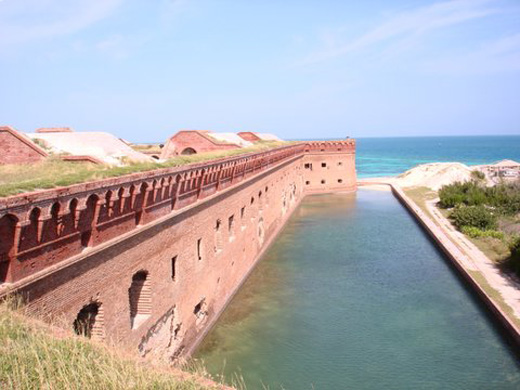

Comments are Closed